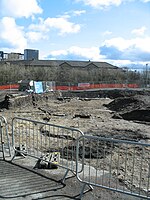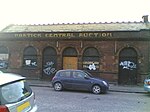Partick Police Station
1853 establishments in ScotlandCategory B listed buildings in GlasgowCity chambers and town halls in ScotlandGovernment buildings completed in 1853Listed government buildings in Scotland ... and 2 more
PartickUse British English from September 2024

Partick Police Station, previously known as Partick Police Court and also as the Old Burgh Hall, is a former municipal and judicial building on Anderson Street in Partick, Scotland. The building, which was previously the meeting place of the burgh council and now serves as the offices of the Centre for Sensory Impaired People, is a Category B listed building.
Excerpt from the Wikipedia article Partick Police Station (License: CC BY-SA 3.0, Authors, Images).Partick Police Station
Gullane Street, Glasgow Partick
Geographical coordinates (GPS) Address Nearby Places Show on map
Geographical coordinates (GPS)
| Latitude | Longitude |
|---|---|
| N 55.8697 ° | E -4.3055 ° |
Address
Gullane Street (Sràid Ghualainn)
Gullane Street
G11 6AH Glasgow, Partick
Scotland, United Kingdom
Open on Google Maps









